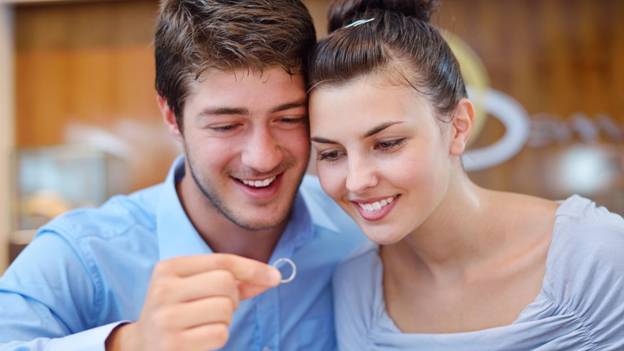11 Engagement Ring FAQs (What to Know When Buying an Engagement Ring)
11 Engagement Ring FAQs (What to Know When Buying an Engagement Ring)
So you want to buy an engagement ring. Congratulations! You must be in love.
Before you kick off your search for the perfect ring for your perfect person, check out these frequently asked questions and learn a lot more about one of the most important purchases you’ll ever make.
1. What Hand Does an Engagement Ring Go On?
In the United States and many other western countries, engagement rings are typically worn on the fourth finger of the left hand. This tradition has deep roots, with historians tracing it back to Romans who believed that there was a vein called the vena amoris (“vein of love”) that ran from the heart to that particular finger. While science later proved that assumption to be anatomically incorrect, the ritual remains.
In other countries, especially where Orthodox Christianity is heavily practiced, engagement and wedding rings may be worn on the fourth finger of the right hand.
Some brides choose to switch their engagement ring to the other hand for their wedding day. That way, their new wedding ring can slide on to the proper finger and sit closest to the heart. After the ceremony, the engagement ring joins the wedding ring toward the outside of the finger and the two pieces of jewelry become a set.
2. How Many Months’ Salary for an Engagement Ring?
How much you choose to spend on an engagement ring is a deeply personal thing. It depends on a great number of factors, including general financial status and how much of your savings you’d like to allocate for the ring, versus other important wedding expenses and other important purchases, such as a honeymoon or a new home.
That said, many experts recommend budgeting two to three months’ salary for an engagement ring. The rule began in the 1930s as part of a marketing campaign that suggested one month’s salary. The idea stuck around and grew to two months’ salary in the 1980s before settling in around three months’ salary in modern times. If that’s in line with what you can afford, great! If not, there are plenty of options for purchasing a simpler but still stunning ring, or you can explore financing options that will allow you to pay off your ring over time.
3. What Finger Does an Engagement Ring Go On?
Engagement rings are worn on the fourth finger of the left hand — in western countries, at least. In the United States, we’ve adopted the ancient Roman tradition of wearing engagement and wedding rings on that finger as a symbol of love. This comes from the Roman belief that the ring finger contained a vein that led straight to the heart (spoiler alert: it doesn’t).
It’s okay to buck tradition, though. Some religions and cultures see wedding and engagement rings worn on the ring finger of the right hand. Other people choose to put their rings on a necklace or adopt other alternatives due to lifestyle requirements or personal preferences.
4. How to Insure an Engagement Ring?
Whether you’re about to buy an engagement ring or already in possession of one and concerned you might lose it, engagement ring insurance should be top-of-mind.
Look for personal jewelry insurance that offers comprehensive, worldwide coverage. Policies that automatically account for new jewelry purchases are especially useful. Though you may be able to insure your rings as part of your renters or homeowner’s policy, the terms aren’t always favorable. Ask your favorite jeweler about their in-house insurance plans before deciding.
5. How Many Carats Should an Engagement Ring Have?
There is no single correct answer to this question, but most sources put the average size of the center stone of an engagement ring at just over one carat. A one-carat diamond can be quite stunning, but size isn’t the only consideration. When buying a diamond, it’s important to take the 4 Cs into account:
- Cut: From classic round cuts to the geometrically fascinating lines of a marquise-cut diamond, a stone’s facets help determine how the diamond will catch and reflect light. That, in turn, influences the overall effect of the diamond itself. Two stones of the same carat weight can appear to be different sizes due to differing cuts.
- Color: Diamond color is rated on a scale from colorless (nearly perfect) to yellow. A D, E, or F-rated diamond will be practically flawless, with the price tag to match. As ratings near the end of the alphabet, the diamond’s color begins to yellow, which is considered undesirable in most cases. The larger the diamond, the easier it is to spot “flawed” color.
- Clarity: A diamond’s clarity is directly related to its imperfections. Blemishes, also called inclusions, will lower a diamond’s position on the clarity scale and make it both less desirable and more affordable.
- Carat Weight: The weight (not size) of a diamond.
6. How to Finance an Engagement Ring
If you’d like to buy a ring now and defer some of the payments until later, consider financing. Depending on your limit, you may be able to use your credit card (or several credit cards). You can also ask your favorite jeweler about their financing options. Look for perks such as:
- Low down payments
- Low minimum purchase amounts
- Interest-free plans
- Payment flexibility
You may also want to ask about how your credit rating will be considered and at what point you will be considered the owner of your jewelry (some policies allow for immediate ownership while others transfer ownership when the payment plan is complete).
7. Which Ring Goes on First: Wedding or Engagement?
Tradition says to wear your wedding ring first so that it’s closest to your heart. For people who decide to have both an engagement ring and wedding ring, this may mean switching the engagement ring to the right hand during the ceremony. That way, the wedding ring can slide onto the left ring finger unimpeded and the engagement ring can be switched back into its rightful place after the ceremony is over.
8. What Size Engagement Ring Is Most Common?
Most engagement ring experts say the average engagement ring size is just over one carat, with about one-fourth of rings sitting at or above the two-carat mark. That means there’s also about one-quarter of rings sitting below the one-carat mark.
Just because lots of people have a 1.2-carat ring (or thereabouts) doesn’t mean that’s what will work best for you. When choosing the size of an engagement ring for yourself or a loved one, consider:
- Budget
- Other quality factors, such as the diamond’s cut, color and clarity
- The size of the wearer’s hand (a larger stone may overwhelm a petite hand while larger frames can typically handle more statement-making jewels)
- Lifestyle factors like job requirements and daily activity levels
- Comfort
9. Can You Return an Engagement Ring if She Says No?
Hopefully you’ll never find yourself in this scenario, but if you do find yourself with an engagement ring and no fiancée, it’s important to call your jeweler immediately. Return policies differ from company to company. Some allow returns during a specific time frame. Others charge a restocking fee (meaning you won’t get a full refund).
Remember that almost all return policies will come with a laundry list of requirements, such as including all the original documentation and ensuring the ring is in pristine condition. It’s also very difficult (if not impossible) to return custom-made and design-your-own engagement rings, as they’re one-of-a-kind and not intended for sale to the general public.
10. Does the Size of the Diamond on a Wedding Ring Matter?
It only matters if it matters to you and your betrothed. Jewelry is deeply personal, perhaps no piece more so than an engagement or wedding ring. What feels small to one person may be perfect for another. A large, flashy ring may not be the most comfortable fit for your friend, but it could be an absolute dream-come-true for you.
Think about the hand the ring will sit on. Will the ring you’re considering feel proportional to the finger underneath? Look at other elements, too, such as cut and color. You can get a large ring with several inclusions for a more reasonable price than a large diamond that’s absolutely perfect, or you can theoretically invest a similar amount in a smaller ring that’s highly rated instead.
11. How to Get Your Wedding Rings Engraved
Anytime you want to get fine jewelry engraved, it’s crucial to entrust the job to an experienced jeweler. After all, you’re looking to alter a ring that’s meant to last a lifetime. There’s no room for mistakes!
Ask about engraving at the time of purchase if you know from the get-go that you want to add a special saying or your monogram to the back of your ring. If you decide to get your rings engraved later, ask the jeweler who made your rings if they’re able to take on the task. Most will agree; those that don’t do engraving will likely know exactly where you should go.
Engagement ring shopping may seem mysterious at first, but hopefully these insights helped make your ring hunt a lot more fun. When in doubt, go with your gut. You know your better half better than anyone. If you love it, it’s probably perfect.



POST COMMENT